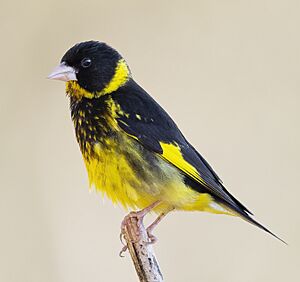Vietnamese greenfinch facts for kids
Quick facts for kids Vietnamese greenfinch |
|
|---|---|
 |
|
| Conservation status | |
| Scientific classification | |
| Genus: |
Chloris
|
| Species: |
monguilloti
|
| Synonyms | |
|
Carduelis monguilloti |
|
The Vietnamese greenfinch (scientific name: Chloris monguilloti) is a small songbird. It belongs to the finch family, called Fringillidae. This bird lives only in the Đà Lạt Plateau area of southern Vietnam. It likes to live in open pine forests and bushy areas on mountains. Sadly, its home is shrinking because of habitat loss.
Contents
What is the Vietnamese Greenfinch?
The Vietnamese greenfinch is a small bird. It measures about 13.5 to 14 centimeters long. This is roughly the length of a pen. It weighs between 15 and 16 grams. That's about the weight of a few coins.
How to Identify a Vietnamese Greenfinch
This bird has a large, cone-shaped beak. Its head is black. It also has a bright yellow band around its neck. Female greenfinches look similar to males. However, their colors are not as bright.
Where Does the Vietnamese Greenfinch Live?
The Vietnamese greenfinch is native to the Đà Lạt Plateau. This area is located in southern Vietnam. It lives in open pine forests. These forests have Pinus kesiya trees. The bird also likes forest edges and new plant growth.
Greenfinch Habitat and Elevation
You can find these birds at high places. They live from 1,050 to 1,900 meters above sea level. Sometimes, they are seen as low as 600 meters.
What Do Vietnamese Greenfinches Eat?
These birds mostly eat seeds from pine trees. They have also been seen catching termites. They catch termites that have just hatched.
How Was the Vietnamese Greenfinch Discovered?
The first official description of this bird was in 1926. An American bird expert named Jean Théodore Delacour described it. He gave it the scientific name Hypacanthis monguilloti.
Changing Names: From Carduelis to Chloris
Greenfinches used to be in a group called Carduelis. But scientists used molecular phylogenetic studies. These studies look at DNA. They found that greenfinches were not closely related to other Carduelis birds. So, they were moved to a different group. This group is called Chloris.
The Meaning Behind the Name Chloris
The name Chloris comes from Ancient Greek. It means "greenfinch." A French scientist named Georges Cuvier first used this name in 1800. The second part of the name, monguilloti, honors someone. It is named after Maurice Antoine François Monguillot. He was an important leader in French Indochina. This bird is also monotypic. This means it is the only species in its group.


